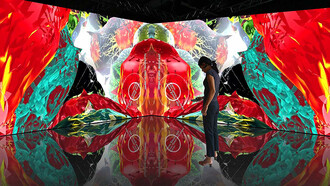Ennio Morlotti (Lecco, 1910 – Milano, 1992) presented Tre bagnanti in February 1992 at a solo exhibition at the Galleria Ruggerini and Zonca in Milan, a few months before his death. That painting, one of the last he created, marks the culmination of forty years of tireless research and reflection on the theme of the nude and the landscape. It can be seen as one of the many treatments of a motif, that of the bathers, which has been popular throughout the history of art, from Titian, Correggio, Giorgione, to Renoir, Cézanne, Kirchner, to name just a few. Testori regarded Tre bagnanti as a section of what he defined “the new polyptych of our national Ennio”, that is a wide series of oils and drawings in which the painter expressed his creativity for the last time.
Throughout almost his entire career, Morlotti worked in cycles, whose subjects – cacti, skulls, rocks, bathers – fully condense the meaning of existence, which is conceived as an inextricable interlacement of life and death instincts. Life itself is the ʻmain subject’ of his works. However, he believed that life is no longer real when it is transposed into art, but it is rather imagined, remembered and coloured with a plethora of new emotions. As Gianfranco Bruno wrote: “Beyond appearance, reality grows in the mind that conceives it”. Thanks to this surplus of feelings, the work is able to move the viewers and to awaken in them the élan vital. Morlotti was also aware of the fact that life has not only a ʻsoulʼ, but also a ʻbodyʼ and, for that reason, his paintings are made of thick and dense matter.
Morlotti began to explore the theme of the nude in 1937 when, at the Universal Exposition in Paris, he was dazzled by the beauty of Cézanne's painting, The Great Bathers, which is now kept at the Museum of Art of Philadelphia. When he was interviewed thirty years later, in 1964, by Marco Valsecchi, the painter explained that The Great Bathers was the painting that had left the strongest impression on him: “It was like a punch in my gut. That blue, those oranges, and the roughness of that painting. I had already met Cézanne in my books; but at that moment, in front of his canvas, my eyes and soul burst open. I felt that he was a Painter; but also that he was a guide for life because of his loneliness, his stubbornness, his determination at work (…)”. From that moment on, Morlotti started a lifelong engagement with the theme of the nude, but, even more significantly, with Cézanne, his dear and beloved teacher, to whose model he would always remain faithful.
Once he was back in Milan, Morlotti did not immediately take up painting again: he preferred to reflect on and internalize the lesson of the discoveries he had made in Paris, including Picasso's Guernica. It was only after two years that he started to create new works, especially landscapes. In that same period, he joined the group “Corrente” and then, in 1946, the one called “Fronte nuovo delle arti”. At the Venice Biennale in 1954, Morlotti exhibited his first emblematic series of nudes, which was imbued with extraordinary passion and vital euphoria. These nudes were set against a landscape made of thick pictorial material, thus conveying the impression of a panic fusion between man and nature. These paintings were then destroyed by Morlotti himself due to the poor success they had obtained at the exhibition.
Despite that unfortunate episode, from 1955 to the early 1960s, Morlotti lived a fruitful creative period, which allowed him to emerge as a leading figure of Italian Informal art. He devoted himself to the investigation of a variety of subjects, such as the banks of the Adda, cornfields, marigolds, intertwinings of leaves and vegetation, bathers. According to Roberto Tassi, the reflection on the human figure was, already at that time, the most significant motif of his painting: “The dramatic essence of life, eroticism, is manifested in Morlotti's human figures. Eroticism is the basis of Morlotti's work; it is the element closest to the Existence”. Since eroticism is the fundamental instinct that keeps us alive, it is used by the painter as a driving force to model human shapes on the canvas. However, eroticism is not only a creative force, but also an “eroding force”: while it creates the shapes, it also breaks them up and blends them with the landscape “in a crackling and total fire” in which nature and flesh can no longer be distinguished. This is clearly one of the many existing expressions of the classic association of Eros and Thanatos.
In 1988, Morlotti created a new important cycle of bathers, “the brilliant resurrection of the theme” and the greatest outcome of his artistic research, which he presented that same year at the Venice Biennale, and then, in 1992, at the Galleria Ruggerini and Zonca in Milan. Once the heavy accumulations of thick pastes have been removed, these new sensual bathers, which are hit by a clear and diffused light, finally appear free from the shapeless matter in which they were imprisoned. The essence of the woman-nature fusion no longer consists in a violent and sudden combination of elements, but in the enveloping and immobile light that penetrates them like lifeblood. Testori affirmed that these works are marked by extraordinary lyricism and poetic qualities which move the viewer to tears. Morlotti confessed to Marco Valsecchi: “I would like to stir up that emotion that cannot be explained, but that can be experienced, as the things of poets are. The painting must reveal something new, even terrible, but something which concerns man”. Morlotti also gave new life and even greater intensity to the colours, shapes, and architecture of Cézanne's paintings. Ironically, the century, which had opened with The Great Bathers and the death of Cézanne, ended with Tre bagnanti and the death of Morlotti, devoted pupil of the great French painter.















